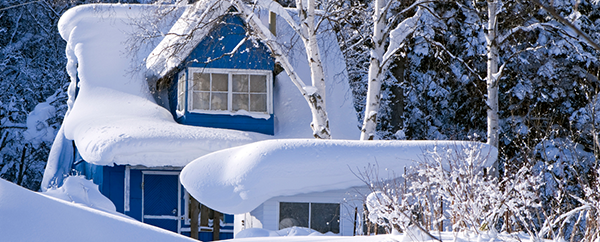Protect your roof with these snow and ice removal tips
- Excessive snow and ice build-up cannot only damage a roof – it can cause a collapse.
- Know your roof: Its integrity, slope, and where snow and ice seem to pool.
- How to stay on top of snow and ice removal from your roof.
Parts of the country have experienced record snowfall this year, and winter is far from over. While snow and ice removal may bring to mind shoveling walkways and scraping ice off windshields, removing snow and ice accumulations from rooftops and awnings is an equally important practice. That’s why we’re presenting these timely snow and ice removal tips.
Water damage is often the focus of risk prevention for roofs, but excessive snow and ice buildup can also introduce the risk of collapse. Winter precipitation can be visually deceptive, making it hard to judge just how much weight your roof is holding at any given time. If you haven’t done so lately, we recommend taking some time to refresh your maintenance staff on the snow load capacity of any facility you may own, and to continually assess and address snow and ice accumulations. Stay on top of snow and ice removal this winter with the following steps.
Related: Winter storm mitigation: How to weather the extremes of snow and cold
Step 1: Know your roof
Each facility is different, and a “one size fits all” approach may not be suitable for roofs of varying designs. Consider the following questions when assessing a roof for the potential risk of collapse or water damage due to snow and ice accumulation:
Slope. Is your roof steep? Is it a gradual slope? Is it flat? These will be important factors in determining how much snow is likely to accumulate at any given time, how quickly it may melt, and what kind of drainage or refreezes you can expect to see accumulating at awnings.
Continuity. Does your skyline follow a symmetrical pattern, or is it varied? Are there covered porches or walkways? Are some portions of your building taller than others? Snow and ice tend to accumulate more rapidly on overhangs and in places where lower sections of the roof meet up against taller portions of the building. Knowing in advance which areas of the roof are more susceptible to buildup and potential drifting is important knowledge for your maintenance personnel.
Integrity. How old is your roof? What is its maintenance history? How much weight is it rated to bear? According to the Insurance Institute for Business & Home Safety (IBHS), the roof of an average residential building can carry up to 20 lbs. per square foot before coming under stress. However, it is very likely this number may vary across other kinds of commercial facilities. If the weight rating of your roof is not known, we recommend hiring an appraiser to assist your maintenance staff in determining how much snow and ice it can safely bear.
Related: Steps to prevent winter property damage to roofs
Step 2: Accurately interpret snow and ice loads.
While rain, snow, and ice are all made of the same basic element, they are all very different in terms of volume and weight. These two properties can be especially tricky to judge for snow, as it comes in a multitude of its own unique forms: fresh, powdery, wet, hard-pack and so on. The following information can help you stay on top of snow and ice removal this winter by illustrating how volume and weight are not always relative:
5 lbs. per square foot is equal to (approximately):
- One inch of standing water
- Ten to twelve inches of fresh snow
- Three to five inches of packed snow
- One inch of ice
Related: Loss control tips to prevent winter freeze-ups
Step 3: Continuously monitor roof accumulations.
Winter precipitation is often a cumulative process. Consider the following scenario of a flat, residential roof with an inadequately maintained drainage system:
- A winter storm deposits a foot of fresh snow.
- A week of temperature fluctuations causes some of the snow to melt and then refreeze in a two-inch layer of ice.
- As time passes, the remaining snow gradually compresses into packed snow.
- Overnight freezing rain seeps into the packed snow, adding an additional inch of water weight to the snowpack.
- A second winter storm deposits an additional foot of fresh snow upon the roof, which also compresses over time.
This fictional roof is now dangerously close to bearing upwards of 20 lbs. per square foot. Depending on how well the roof has been maintained, or whether it sustained water damage in previous winters, parts of the roof may have become susceptible to collapse long before reaching the 20 lb. per square foot average.
Regardless the scenario, the important thing to remember is that a roof’s snow load is a constantly evolving scenario, and the weight of snow and ice can be visually deceiving.
Related: 9 ways you can help your homeowners winterize for the cold weather
Step 4: Stay on top of snow and ice removal this winter
It’s important to have mitigation strategies in place should your roof start to become overburdened. If you own facilities in regions where heavy snowfall is a regular occurrence, investing in a roofing heat cable system might be a solution worth exploring.
In lieu of that, regularly removing snow and ice with roof snow scrapers may be something to consider adding to regular maintenance workflows. Alternatively, contracting with a company that specializes in snow removal may also be something to consider.
Agents, take a look at our Homeowners Program to add to your portfolio of insurance solutions.
This article was originally published on Arrowhead’s Tribal blog. It has been modified and updated to better fit the needs of our other producers and their clients.

